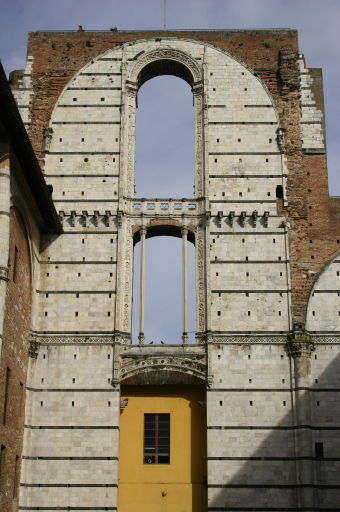
|
|
The visible remains of the uncompleted project to make a yet more magnificent, larger cathedral. |





|
|
The visible remains of the uncompleted project to make a yet more magnificent, larger cathedral. |
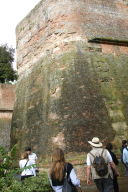
We arrived in Siena at about 5:15, and our bus was met by our guide Donatella, a short, slender woman of about sixty with a deep, powerful, and authoritative voice, who knows a great deal about her city, and how to present it to best effect.
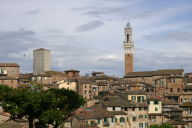
|
| Big image, small |
The city is still surrounded by its medieval wall (thumbnail to the left, small version only), and we were soon surrounded by the town itself.
Donatella led us in an indirect route to the Cathedral, the biggest attraction in the city. Along the way, she pointed out the headquarters of the Monte dei Paschi bank, the oldest surviving bank in the world. That’s it to the left, left thumbnail. (Big image, small.)

|
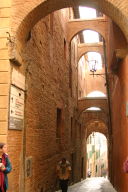
|
The right thumbnail to the left is a picture showing how some of the oldest buildings have buttresses between them—you know you’re in a medieval city when you see that! (Big image, small.)
| ||||||||||||
| ||||||||||||
|
But let me simply quote from my journal:
We walked through a number of squares, including one where the world’s oldest bank stood, but the whole purpose was to lead us to the Duomo in the most dramatic and breathtaking manner. We approached from behind, from the West and North, I suppose, first with just a glimpse through a narrow gap between two buildings. And then around to the East Façade, extremely busy with most of the statuary in replica, the originals being too worn, and preserved in the Church Museum.
There was so much to see, so much to look at, just standing outside, that I took loads of pictures, all to the right, which you can feast on to your pleasure.
And then we went in.
To be overwhelmed.
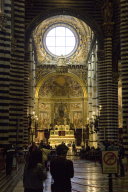
|
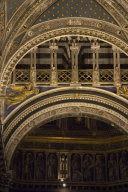
|
| Big image, small | Big image, small |
It was as surprising as the Grand Mosque, and for some of the same reasons. Same strong dependence on architectural color; or should I say the same architectural use of color. Same vastness, though in openness rather than in horizontal extent. And really, the element of surprise had something to do with it. (But I think the lighting in the Mosque was much more tasteful than that here.)
No bright colors at all: just the white and black marble in contrasting horizontal bands. The architecture was wonderful, but what really took my eye were the astonishing and endlessly fascinating floor panels in colored marble.
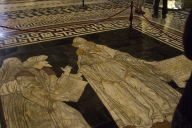
|
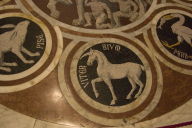
|
| Big image, small | Big image, small |
Many of these were devoted to explaining the conventional medieval notion that Jesus’s birth and mission were predicted not only in the Hebrew Scriptures, but by various sages of pagan antiquity, like (the wholly mythical) Hermes Trismegistus and the Cumaean Sybil. You see this notion in the line “teste David cum Sybilla” from the Dies Iræ —“in accordance with the testimony of David and the Sybil”. The first panel I’ve shown, above and to the left, has Hermes Trismegistus with two other figures.
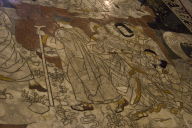
|
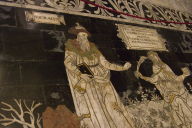
|
| Big image, small | Big image, small |
But you must rest assured that it wasn’t theological concerns that made me drop my jaw at these panels. It was the eye-popping technique of what can only be described as marquetry-in-stone and stone inlay. The panels are made primarily of black and white marble, with accents, or sometimes larger background sections, in marbles of other colors, especially red-brown. But there are super-special accents in gold marble! Donatella told us that the veins of this color of marble are completely exhausted: no gold marble for your formal garden any more. As an aside, let me point out that almost all the information you may read will refer to these panels as “mosaics”—but this seems all wrong to me, since there are no tesserae. The designers and craftsmen who made these panels showed an artistry and artisanship entirely different in nature from that of the mosaicists.
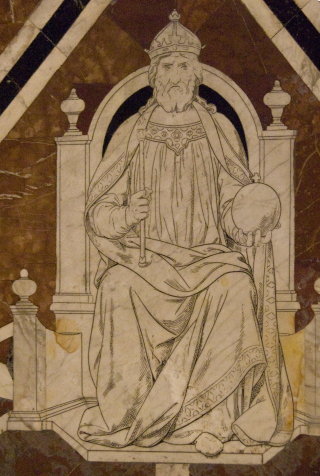
In the second image above, you see parts of three medallions relating to the cities of Pisa, Viterbo, and Perugia. The heraldic animals are in marble, with shading simply achieved by engraving. In most of the other panels, the black lines seem to have been achieved by carving out a channel, into which black marble was inlaid.
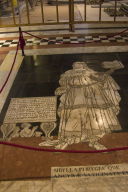
|
|
Phrygian Sybil Big image, small |
I’m afraid that I didn’t make any notes of what the various scenes depicted; what’s going on in the third image above is a mystery to me. But you see Socrates in his fancy hat in the next picture. The Latin in the inscription is beyond my abilities to translate. On reviewing my pictures, I decided that I really liked the picture I took of God the Father enthroned. He was considerably distorted by the perspective, of course, and I made the big picture to the left by Photoshopping Him to undo the distortion. You can see my original pictures in big and small versions. Notice that the technique here is very different from that in many of the other panels: all the details, I think, have been done in engraving rather than in inlay.
The picture of the Phrygian Sybil to the right is one of the few I took that give an idea of how very big these panels are.
Many, perhaps most, of the floor panels are covered over with sheets of plywood or other similar material, so that the liturgical business of the Cathedral can go on without the congregation stepping all over the artworks. But the coverings are lifted for a period of about a month or two every late Summer, at the time of the Palio, the famous horserace. It would be well worth while, I think, to make a special trip to Siena at this time of year.
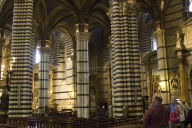
|
|
Lower right: Mark, Claire, and Glenn (Big image, small) |
I just realized that in the picture to the right, the man that you see to the right of Claire is, himself, dressed like the Cathedral. Most appropriate. (You’ll have to view the image in its large version to see it, I think.)
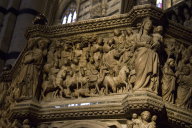
| ||||
|
But wait! this was not all! There’s the famous pulpit by Nicola Pisano in Carrara marble that is considered one of the great treasures of the Duomo, shown to the left (big image, small). I suppose I should have taken more snaps of it, but this’ll have to do.
And we can’t omit mention of the Piccolomini Library. The entrance to it is adorned with a fresco by Pinturicchio that I admired greatly. It shows the papal coronation of Pius III, who commissioned the library in honor of his uncle Pius II.

But inside the Library it’s even better. You’ll see photographs of much higher quality elsewhere: I decided, as I frequently have, not to try to compete with the art texts, but took only the one picture that you see to the right (big image, small). All the frescoes, by Pintuicchio still, are beautifully preserved (and restored, I assume), with brilliant color, much more so than the painting by the same artist outside the Library. This single room, too, is fine enough by itself to justify the trip to Siena.
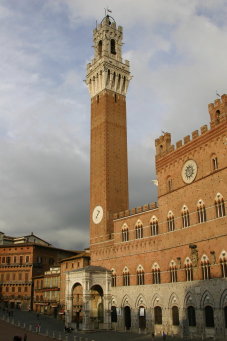
Reeling, we left the Duomo, and made our way to the Piazza del Campo, shown above (big image, small), where we bade farewell to Donatella and planned the rest of our evening. This was to be another “free meal”, in other words our own responsibility, which made sense in light of the immense meal we had had at lunch. From the Piazza, we had a nice view of the Palazzo Pubblico (town hall) and its Tower, called the Torre del Mangia (big image, small).
Mark and I wandered around the Piazza looking for touristy things to buy: a refrigerator magnet sufficed, as usual. Then we made our way to an unpretentious restaurant looking out over the square, where we had a very light meal. A half-bottle of wine, and for me a Zuppa Senese. That’s a white bean soup made of a rich broth, and heavily garlicked. Delicious, but I tasted it all the way back to Radda.
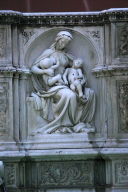
We still had time to kill, so we just hung around the square, chatting with the others. Both of us took pictures of the nice marble statuary behind the fountain there. My friend Robert K claims that it’s the earliest depiction in European art of the Virgin giving suck to the Babe. I suppose that that’s John the Baptist sleeping in her left arm. (Big image, small.)
Then a ride back to Radda, and to bed. A wonderful day!
Next day’s pictures, first half of today’s pictures, previous day’s pictures. Return to the central Italy page; to the central travel page; to my home page.